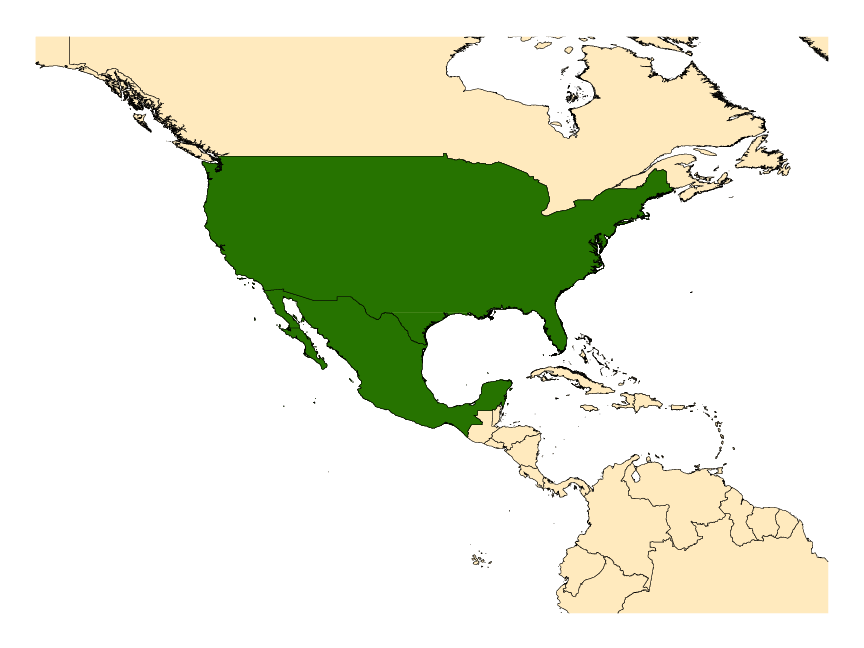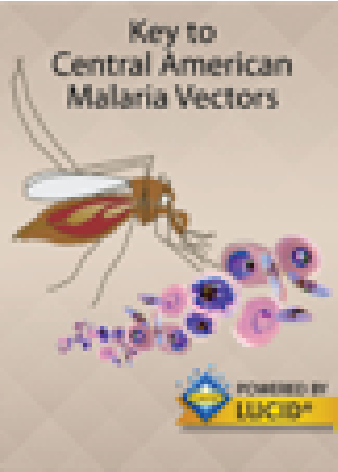NEARCTIC REGION
Etymology: Aztec area of central Mexico
Anopheles (Anopheles) aztecus is an unplaced member of the Holarctic Maculipennis Group, the members of which are typified by their distinctive spotted wings. It is the most southerly distributed member of the Nearctic species, and, in common with its southernmost Palearctic cousin, Anopheles sacharovi Favre, the species is considerably paler than any of its more northerly relatives.
Type locality: Valle de Mexico [Mexico City & surroundings, Mexico]
Type depository: Laboratorio de Entomologia, Instituto de Biologia, Universidad de Mexico, Mexico, D.F., Mexico (UM)
DIAGNOSTIC CHARACTERS (Click photos to view; mouse over and click large photo to zoom in.)
ADULT (illustrated): Head: Scales and setae of interocular space, and usually pale scales of vertex, golden yellow. Palpus unicolorous, without contrasting pale markings. Wings: Dark scales (including fringe at apex); scales darker and/or more-dense at cross veins and bifurcations, forming faint dark spots. Legs: legs without contrasting bands.
LARVA (not illustrated): Head: Setae 2,3-A pointed; seta 2-C thick, separated by a space >2 x diameter of one alveolus at base; seta 3-C dendritic, highly-branched. Thorax: Setae 9–12-P single. Abdominal segments: Seta 0-IV,V minute.
TAXONOMIC KEYS
Pelaez 1945
Vargas & Martínez Palacíos 1956
Wilkerson & Strickman 1990
![]()
Anopheles – Central America – Adult
![]()
Anopheles – Central America – Larva
![]()
WRBU - Genera - Global - Adult
![]()
WRBU - Genera - Global - Larva
![]()
WRBU - Genera - Nearctic - Adult
![]()
WRBU - Genera - Nearctic - Larva
Exemplar DNA sequences
An. aztecus 28S rDNA: L78466
BIONOMICS
Immatures
Typically found in surface freshwater habitats, including ditches, lakes, ponds, and canals, but also reported from gutters and pools of clear water.
Adults
Highly anthropophilic. Primary vector of Plasmodium vivax malaria in Mexico. Often sympatric with (but always more abundant than) Anopheles pseudopunctipennis. Colonizes easily and is often used as an Anopheles model in Plasmodium infection studies, where midgut infection rates of up to 70% are common.
DISTRIBUTION NOTES
Mexico, United States (Contiguous Lower 48)

WRBU VECTOR HAZARD REPORTS
None; View other WRBU Vector Hazard Reports
Available GIS Models
None
IMPORTANT REFERENCES (full citations below)
Hoffman 1935: 5 (M*, F*, L*, E*; as maculipennis ssp.)
Vargas 1939: 356 (to species)
Vargas 1941d: 113 (E*)
Aitken 1945: 304 (M, F*, L, E; taxonomy)
Pelaez 1945: 74 (F*; key)
Penn 1949b: 58 (P*)
Pratt 1952 (P*, L*; taxonomy, distribution)
Vargas & Martínez Palacíos 1956 (keys: M*, F, P*, L*, E)
Baker & Kitzmiller 1964 (chromosomes*)
Dodge 1966: 361 (1st instar L*; key)
Kitzmiller et al. 1967: 173 (chromosomes*)
White 1978 (taxonomy, review, keys, distribution)
Wilkerson & Strickman 1990 (F*; key, distribution)
Porter & Collins 1996 (molecular phylogeny, Nearctic)
Muñoz-Cabrera et al. 2006 (M, F, L; bionomics, distribution
CURRENT SYNONYMS
None
CITED REFERENCES
Aitken, T.H.G. (1945). Studies on the anopheline complex of western America. University of California Publications in Entomology, 7(11), 273–354.
Baker, R. H., & Kitzmiller, J.B. (1964). The salivary gland chromosomes of Anopheles aztecus. Revista del Instituto de Salubridad y Enfermedades Tropicales (Mexico), 24, 43–54.
Dodge, H.R. (1966). Studies on mosquito larvae II. The first-stage larvae of North American Culicidae and of world Anophelinae. Canadian Entomologist, 98, 337–393.
Hoffmann, C.C. (1935). La formacion de razas en los Anopheles mexicanos I. A. maculipennis y A. quadrimaculatus y una raza nueva del maculipennis. Anales del Instituto de Biologia (Universidad Mexico), 6, 3–22.
Kitzmiller, J.B., Frizzi, G. & Baker, R.H. (1967). Evolution and speciation within the maculipennis complex of the genus Anopheles. Genetics of Insect Vectors of Disease. Wright & Pal, Editors. Elsevier Publishing Co., Amsterdam. Ch. 5. pp.151-208.
Muñoz-Cabrera, L. O., Ibáñez-Bernal, S., & Corona-Vargas, M.d.C. (2006). The mosquitoes (Diptera: Culicidae) of Tlaxcala, Mexico. I: checklist of species. Los mosquitos (Diptera: Culicidae) de Tlaxcala, Mexico. I: Lista comentada de espécies. Folia Entomologica Mexicana, 45(3), 223–271.
Pelaez, D. (1945). Anofelinos de México. Clave para la determinación de especies y subespecies basada en los caracteres de las hembras adultas. Ciencia, 6, 69–77.
Penn, G.H. (1949b). The pupae of the mosquitoes of New Guinea. Pacific Science, 3, 3–85.
Porter, C.H. & F.H. Collins (1996) Phylogeny of Nearctic members of the Anopheles maculipennis species group derived from the D2 variable region of the 28S ribosomal RNA. Molecular Phylogenetics and Evolution, 6(2), 178-188.
Pratt, H.D. (1952). Notes on Anopheles earlei and other American species of the Anopheles maculipennis complex. American Journal of Tropical Medicine and Hygiene, 1, 484–493.
Vargas, L. (1939). Datos acerca del A. pseudopunctipennis y de un Anopheles nuevo de California. Revista Medicina de Mexico, 19, 356–362.
Vargas, L. (1941d). Nota sôbre los huevecillos de Anopheles mexicanos. Gaceta Médica de Mexico, 107–123.
Vargas, L., & Palacios, A.M. (1956). Anofelinos mexicanos. Taxonomia y distribucion. Secretaria de Salubridad y Asistencia, Comicion Nacional para erradicacion del paludismo, Mexico, DF, Mexico.
White, G.B. (1978). Systematic reappraisal of the Anopheles maculipennis complex. Mosquito Systematics, 10(1), 13–44.
Wilkerson, R.C., & Strickman, D. (1990). Illustrated key to the female anopheline mosquitoes of Central America and Mexico. Journal of the American Mosquito Control Association, 6, 7–34.
CITE THIS PAGE
Walter Reed Biosystematics Unit (Year). Anopheles aztecus species page. Walter Reed Biosystematics Unit Website, http://wrbu.si.edu/vectorspecies/mosquitoes/aztecus, accessed on [date (e.g. 03 February 2020) when you last viewed the site].












































































































































































